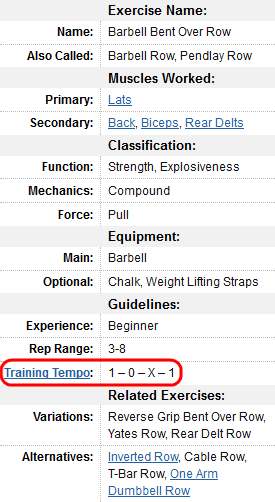What is weight training tempo? On this page, I’ll explain all you need to know about understanding and using training tempo for lifting weights.
Specifically, I’ll discuss the importance of tempo, how to write it and the common tempos commonly prescribed for different training objectives.
What Is Weight Training Tempo?
Weight training tempo refers to the rhythm of a repetition for a given exercise.
It is measured by the time spent on each of the four phases of a repetition. The phases of the rep are as follows:
- Eccentric rep (lowering the weight)
- Midpoint (bottom of the rep for exercises starting with the eccentric; top of the rep for exercises starting with the concentric**)
- Concentric rep (lifting the weight)
- Starting point
** For some cable exercises, it makes more sense to think of the “top” of the rep as the point where the target muscles are fully contracted; and the “bottom” of the rep as when the target muscles are fully stretched. Let’s use triceps pushdown as an example: The “bottom” of the rep is when the bar is higher and your elbows are fully bent, and the “top” of the rep is the bar is lower and your elbows are fully extended.
Tempo Training vs. Velocity Based Training
It’s important to note that tempo is different than velocity (i.e. bar or body speed). However, tempo and velocity are correlated (i.e. faster tempo = higher velocity, slower tempo = lower velocity).
In many cases, either method can be used to achieve the same training objective (e.g. speed/explosiveness training, max strength, hypertrophy, power).
However, all else being equal, velocity based training will produce better results over time — assuming you have a velocity tracking device like the Beast Sensor that can accurately measure and record bar/body speed.
How to Write Tempo for Weight Training
An example of how tempo is written is as follows: 2 – 1 – 1 – 0
The chart below shows what this tempo means.
| Seconds: | 2 | 1 | 1 | 0 |
| Phase: | Eccentric | Midpoint | Concentric | Starting point |
So if this 2 – 1 – 1 – 0 tempo was for the barbell squat (which starts with the eccentric) it would entail:
- 2 seconds to squat down to the floor
- 1 second pause at the bottom of the rep
- 1 second to squat up until standing upright
- 0 second pause in the starting position
1, 2, 3 and 4 are in the order that the rep is performed. This is the case for all exercises starting with the eccentric, which makes it easy to understand.
Now, if the 2 – 1 – 1 – 0 tempo was for the barbell curl (which starts with the concentric), it would mean:
- 2 seconds to lower the bar to your thighs
- 1 second to squeeze biceps the at the top
- 1 second to curl the bar up to shoulder-level
- 0 second pause in the starting position
1, 2, 3 and 4 are not in the order that a rep is actually performed. This can be slightly confusing, but it is correct; and it is the case for all exercises starting with the concentric.
Notation for an Explosive Training Tempo
Some exercises are best performed explosively. That means that the concentric rep is done as fast as possible (without sacrificing good form).
The notation used to signify an explosive concentric is an ‘X’ as is shown in the example below.
| Seconds: | 1 | 0 | X | 1 |
| Phase: | Eccentric | Midpoint | Concentric | Starting point |
Types & Importance of Weight Training Tempo
There are tons of different training tempos out there. But I’m not going go over them all.
However, I’ll list a few of the most common ones that are applicable to strength and muscle building:
- 2 – 0 – 1 – 0 or 2 – 0 – 2 – 0 for any non-upper back, non-explosive movements (i.e. general purpose)
- 2 – 1 – 1 – 0 for upper back pull exercises (e.g. seated cable row, t-bar row, cable face pull)
- 2 – 0 – X – 1 or 1 – 0 – X – 1 for explosive pull exercises (e.g. Pendlay row, power clean or deadlift)
- 2 – 3 – 1 – 0 or 2 – 3 – X – 0 for training explosiveness on squats and bench press
The importance of tempo depends primarily on your experience level and your goals…
…If you’re new to lifting, you should pay more attention to tempo – actually counting in your head if it helps – so that you’re able to lower the weight slowly and lift it using the right muscles.
And if you’re more advanced, but have a specific goal in mind, then focusing on training tempo may also be important. The type of tempo, of course, depends on the specific goal. But like I mentioned earlier, the purpose of this post is not to present an exhaustive list of training tempos.
Generally, though, you don’t have to be super strict about training tempo.
Here’s some loose, but practical rules that will get you by for most exercises:
- Control the weight on the eccentric
- Go faster on the concentric, while still being able to activate the target muscle(s)
- Squeeze (even if just briefly) at the top if the lift starts with the concentric
Weight Training Tempo on Kingofthegym.com
In all of the weight lifting exercise guides on Kingofthegym.com, I put a recommended tempo in the exercise information chart (as shown in the image on the right).
Please realize that these are just general guidelines.
You don’t have to use the recommended tempo if it feels wrong to you or if it’s not conducive to your goals.


